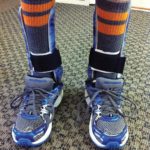Devices increased step width, speed
By Katie Bell
Children with bilateral spastic cerebral palsy (CP) experience improved gait function when walking with ankle foot orthoses (AFOs) versus barefoot one year after lower limb surgery, according to research from Norway. The impact of AFOs was most evident in children with greater gait dysfunction preoperatively, supporting use of the devices in this population, according to the findings.
Lead author Ingrid Skaaret, CPO, MSc, a prosthetist-orthotist in the Department of Child Neurology, Rikshospitalet, Oslo University Hospital, and a PhD student at the University of Oslo, said, “Practitioners and patients should be prepared that gait problems may not be completely resolved after lower limb surgery and the first rehabilitation period. AFOs may be useful for shorter or longer periods, particularly for children with severe gait problems preoperatively, who required more surgery and more mechanical support to help maintain the effect of the surgery.”
The prospective cohort study included 34 children (12 girls) with bilateral CP and a mean age 11 years. Participants underwent 3D gait analysis preoperatively while walking barefoot and one year postoperatively while walking barefoot and with AFOs. Outcome was assessed via the gait profile score, which summarizes the overall deviation of kinematic gait data relative to normal data, along with key kinematic, kinetic, and temporal-spatial variables. A 1.6° or greater change in the gait profile score was used as an indication of clinically important improvement.
The results showed the children had major improvements in the gait profile score and key variables when walking barefoot one year postoperatively. With AFOs, children had improved step length and velocity, additional moderate reduction/improvement in gait profile score and knee moments, and decreased stance ankle dorsiflexion compared with postop barefoot walking. Additionally, the 14 children who used ground-reaction AFOs showed a decreased stance knee flexion of 8.2° from 13.9° when walking barefoot.
“Many children in this group had remaining crouch one year postoperatively, probably due to muscle weakness, and walked with excessive ankle dorsiflexion and knee flexion. This gave more potential for correction,” Skaaret said. With ground-reaction AFOs, “ankle motion is restrained, and with longer and stiffer lever arms in the construction the intention is to redirect ground-reaction forces and push the knee into extension,” she said.
Additionally, the study found a stronger impact of AFOs in children with more pronounced gait dysfunction preoperatively, a finding Skaaret suggested was probably because those children more frequently had remaining issues one year postoperatively.
“In children with milder gait problems, AFOs could also be of benefit; to improve stability, correct the ankle position, and avoid tripping, among other things,” she said, adding that “the need for AFOs is somewhat individual and should be evaluated in each case.”
Prosthetics and Orthotics International published the findings in August.
Kyra Kane, BSc, PT, MSc, senior physical therapist at the Children’s Program at the Wascana Rehabilitation Centre in Regina, Saskatchewan, Canada, said the study findings support the importance of individualizing AFO prescriptions and monitoring the effectiveness of AFOs over time.
According to Kane, individualizing the prescription to match the child’s needs, “involves objective evaluation, collaborative goal-setting, and identification of the biomechanical rationale for the prescription.”
The study did not measure how the children walked with AFOs before they underwent surgery, so investigators could not compare the impact of AFOs pre-versus postoperatively.
However, Skaaret noted, “In our experience it is more challenging to achieve a good result with AFOs in children who have developed contractures, particularly when there is rotational malalignment leading to in- or out-toeing. In these cases, surgery would have a bearing on AFO success since efficient and comfortable orthotic force transfer is easier after surgical correction.”
Jon R. Davids, MD, assistant chief of orthopedic surgery and medical director of the motion analysis laboratory at the Shriners Hospitals for Children—Northern California in Sacramento, noted that surgical outcome has a bearing on AFO success.
“Orthotic success is dependent upon proper surgery that addresses sagittal and transverse plane deviations at the hip and knee, and corrects foot alignment to facilitate long-term brace wear,” Davids said. “Ultimate surgical outcomes in the functional domain require appropriate orthotic prescription and fabrication, particularly in children with more significant gait impairment.”
The study authors concluded that 3D gait analysis completed one year after lower limb surgery is a useful method to assess treatment outcome in this population. Kane noted that while most clinicians do not have access to 3D gait analysis, making orthotic decisions by eye alone is inadequate.
“The use of video and standardized measures is vital to guide decision-making and fuel discussions with families,” she said. “Recording a quick gait video on a tablet can be a great starting point for a discussion about the rationale for orthotic recommendations or adjustments. It can help monitor changes over time, and ensure clinicians and families stay on the same page about treatment decisions.”
Katie Bell is a freelance writer based in New York City.
Source:
Skaaret I, Steen H, Terjesen T, et al. Impact of ankle-foot orthoses on gait 1 year after lower limb surgery in children with bilateral cerebral palsy. Prosthet Orthot Int 2018 Aug 7. [Epub ahead of print]






